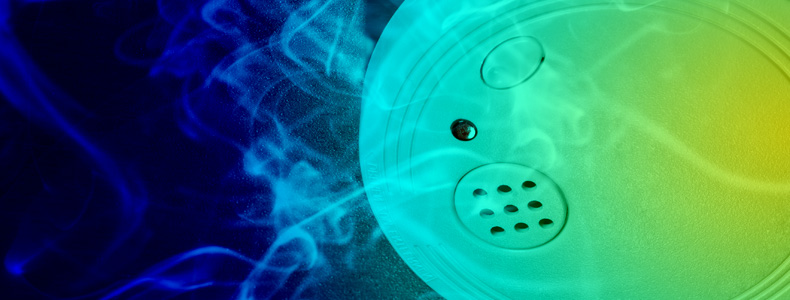The Significance of Smoke and Carbon Monoxide Alarms
In order to help keep yourself and your loved ones safe, it’s important to make sure you have smoke and carbon monoxide alarms installed in your home.
with no smoke alarms (41%) or smoke alarms that weren’t working (16%).4 You will want to change the batteries in your alarms, as battery problems are the most common cause of smoke alarm failures.4
Ensuring both alarms are properly set up and maintained can help increase the chances of remaining safe in the event of an emergency.
Carbon Monoxide Safety
Before installing a carbon monoxide (CO) alarm, it’s helpful to understand what carbon monoxide (CO) is and how to detect signs of exposure.
Carbon monoxide (CO) is found in the fumes produced by furnaces, vehicles, generators, stoves, lanterns, gas rangers, or burning charcoal or firewood. The carbon monoxide (CO) from these sources can build up in enclosed or partially enclosed spaces, which can lead to people and animals dying from breathing in the poisonous fumes.1
The danger levels of carbon monoxide (CO) poisoning ultimately depend on a number of variables, including one’s health and activity level. Infants, pregnant women, and people with physical health conditions such as emphysema, asthma, and heart disease can be more severely affected by lower concentrations of carbon monoxide (CO) than healthy adults would be.2
A person can be poisoned by a small amount of carbon monoxide (CO) over a long period of time or by a large amount over a shorter period of time2, so the best way to make sure you’re not exposed to harmful amounts of carbon monoxide (CO) is by having alarms where you live.
The Dos and Don’ts of Preventing Exposure
Learning actions to take and avoid when it comes to installing and maintaining a carbon monoxide (CO) alarm can help keep you protected.1
Don’t:
- Run a car or truck inside a garage attached to your house, even if you have the door open
- Burn anything in a stove or fireplace that isn’t ventedn
- Heat your house with a gas oven
- Use a generator, charcoal grill, camp stove, or other gasoline or charcoal-burning device inside your home, basement, or garage or outside less than 20 feet from a window, door, or vent
Do:
- Install a battery-operated or battery back-up carbon monoxide (CO) detector in your home and check the batteries whenever you change clocks for daylight savings time
- Learn the symptoms of carbon monoxide (CO) poisoning
- Learn what to do during a power outage
- Have your heating system, water heater, and any other gas, oil, or coal burning appliances serviced by a qualified technician every year
- Leave your home immediately and call 911 if your carbon monoxide (CO) alarm ever sounds
- Seek prompt medical attention if you think you’ve been exposed to carbon monoxide (CO) and feel dizzy, light-headed, or nauseous
Smoke Safety Tips
In addition to protecting yourself and your loved ones from carbon monoxide exposure, it’s beneficial to educate yourself on smoke safety as well.
Smoke alarms are a key part of a home fire escape plan. Having them installed around your residence and keeping them properly maintained may help save your life if danger ever strikes.
Take note of this important information when it comes to smoke and fire safety:3
- A closed door may slow the spread of smoke, heat, and fire
- Large homes may need extra smoke alarms
- It’s possible to purchase smoke alarms for those who are deaf — these can be made with strobe lights and bed shakers
Other installation and maintenance tips include:3
- Install smoke alarms in every sleeping room and outside each separate sleeping area
- Install alarms on every level of the home, including the basement
- Make sure alarms are interconnected — when one sounds, they all sound
- Test smoke alarms at least once a month
- Place smoke alarm on the ceiling or high on a wall
- Keep smoke alarms away from the kitchen to reduce false alarms — at least 10 feet away from the stove
- Replace all smoke alarms when they are 10 years old
Planning an Escape
You will hopefully never be in a situation where you have to escape from a fire. However, knowing what to do in case you were to be caught in one is something everyone should know.
Your first step should be to get everyone in the house together to create a home escape plan. Plan an outside meeting place where everyone will meet once they’ve escaped — somewhere permanent where everyone will stick to.
Additionally, you’ll want to make sure escape routes aren’t blocked and windows open easily. Any windows with security bars or grills should have an emergency release device. Designate a person to help infants, younger children, older adults, or anyone in the household with mobility limitations. Lastly, if your smoke alarm ever goes off, get outside quickly, stay outside, and call 911. Never run back inside a burning building.
Once you’ve educated yourself on carbon monoxide and smoke alarm safely, you can feel more at ease knowing you have the correct safety measures in place in the event of an emergency.
Categories: Home Safety/Childproofing, Product Safety/Recalls, Safety Tips
- https://www.cdc.gov/nceh/features/copoisoning/index
- https://www.nfpa.org/Public-Education/Staying-safe/Safety-equipment/Carbon-monoxide
- https://www.nfpa.org/Public-Education/Staying-safe/Safety-equipment/Smoke-alarms/
- https://www.nfpa.org/News-and-Research/Data-research-and-tools/Detection-and-Signaling/Smoke-Alarms-in-US-Home-Fires
